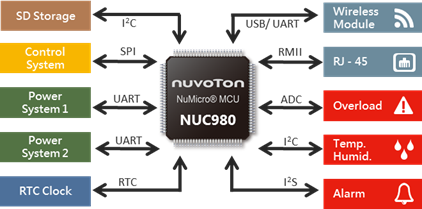China's new infrastructure project: soaring in 5G with Nuvoton
5G is one of the most important infrastructures among the seven fields of China’s new infrastructure; from upstream to downstream and from equipment to application, not only is there support by the government, but every manufacturer on the market is also very anxious. Nuvoton’s microcontrollers range from 8-bit, M0, M23, M4 to Arm9, and have wide product coverage, so how can we find opportunities in the 5G infrastructure?
Base station monitoring/Power management
Since the RF technology of 5G is different, it has a shorter transmission range. Therefore, the greatest difference when compared to 4G is that the number of base stations deployed will increase significantly. A 5G base station not only needs to process RF and baseband signals, but it also needs to monitor the statuses of equipment such as BBU and RRU, etc., as well as manage battery and power equipment to ensure that this expensive system will operate stably. Nuvoton’s NUC980 series supports rich peripheral interfaces that can be used to connect different sensors; it also has two sets of 10/100 network ports that can be used to separate internal and external network segments. Its package software also supports networking protocols that allow the remote control to be achieved easily, and it also uses hardware encryption and decryption engine to protect the transmitted data and realize security. It can also be used with different LQFP package sizes and different built-in DRAM capacities so it can be flexibly designed for the data acquisition, remote control, and power environment monitoring equipment in each of the base stations. If the Linux operating system is not needed, the M480 series can be used, in which M487 is equipped with a 10/100 networking function, secure boot, rich IO and 5 MSPS ADC sampling speed; it can be applied for power management equipment or lightweight gateway products in the base stations.

Antenna control
Not only are there Macro Cells in the deployment of 5G equipment, Small Cells, and Micro Cells are also needed to increase the coverage of RF signals. The cost for deploying Small Cells is cheaper and it can be installed without the need for large space areas; it can be flexibly deployed at corners where macro cell signals cannot cover. Through the mixed macro and small cell architecture, the coverage density and network communication capacity of RF signals can be increased, improving the user service content and network qualities. The locations of Small Cells are usually between several Macro Cells; real-time adjustment of antenna positions can improve the transmission capacity and quality of wireless signals in Small Cells. There are also several mobile Small Cells available on the market that provide temporary and real-time wireless network needs; controlling the angular position of the antenna is even more important for these types of products.
The rich peripherals of the M480 series can satisfy the design requirements of small cell antenna control modules; it provides up to 24 channels of PWM to control step electrical motors, and the peripherals such as 5 channels of I2C, 11 channels of serial ports, 5 channels of SPI can support the feedback requirements of various sensors such as gyroscopes. Also, the M480 series has up to 192 MHz of computing power, providing the fastest real-time computing power.

Not only will the opportunities for 5G base station peripherals grow, but the optical communication needs between base stations will also increase; the IDCs of operators will also need new equipment in response to 5G, including power distributor, server (built-in fan) and IDC monitoring, etc. As for the users, after the receiving terminal receives the 5G signal, the signal will be extended to every corner of the room through equipment such as repeaters and boosters to provide better user experiences. The entire 5G industry infrastructure has many opportunities; with the support of Nuvoton’s all series, over 600 microcontroller products, along with complete ecosystems, it shows that everybody can create more market success opportunities in China’s new 5G infrastructure.